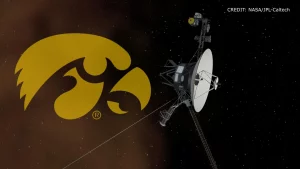UI Still Operating Voyager Plasma Wave Instrument
November 10th, 2024 by Ric Hanson
IOWA CITY, Iowa [KGAN-TV] – Nearly 47 years ago, two NASA spacecrafts were bound for one of the grandest journeys across our solar system to fly by and learn about our outer gas giants. They launched within a special planetary window, which occurs only once every 176 years. It allows these spacecraft to use the gravitational pull of each planet it flies by to alter its trajectory, allowing them to arrive at the next planet on its path with minimal use of fuel.
The Voyager spacecrafts paved the way for our understanding of our solar system, but it’s now over 15 billion miles away from Earth. It takes light and radio signals about 23 hours to reach it one way, and it is still changing our understanding of the cosmos. The instruments still onboard and operational were built, and are still operated by, the University of Iowa’s Department of Physics and Astronomy. One of them is the Plasma Wave Subsystem, which measures subtle waves within plasma fields around planets and in space. 
The instrument has been pivotal in some of our most incredible discoveries in space, including the data set confirming when Voyager entered the interstellar medium beyond our solar system in 2012. It was also instrumental in detecting lightning on another planet for the first time back in the early 80s. Lightning sends off a wide array of electromagnetic waves. Due to the different speeds at which each of these waves travels, it creates an odd, descending whistling tone.
Dr. Bill Kurth, a research scientist at the University of Iowa and a co-investigator of the Voyager Plasma Wave, was part of the initial development of the instrument nearly half a century ago, and continues to monitor data sent back from the aging spacecraft to this day.Of the nearly 10 instruments on board, only four remain. The University of Iowa’s instrument still furthers our understanding of our place in the stars is one of them still in operation.
It’s still uncertain how much longer the voyager probes have left, but predictions show they may make it into the early 2030s. However, they will still be drifting through the vastness of space, likely outliving our own star, the sun, well after they shut down.
You and find more information about the University of Iowa’s involvement in the Voyager missions here or their involvement in a multitude of flagship NASA missions here.





